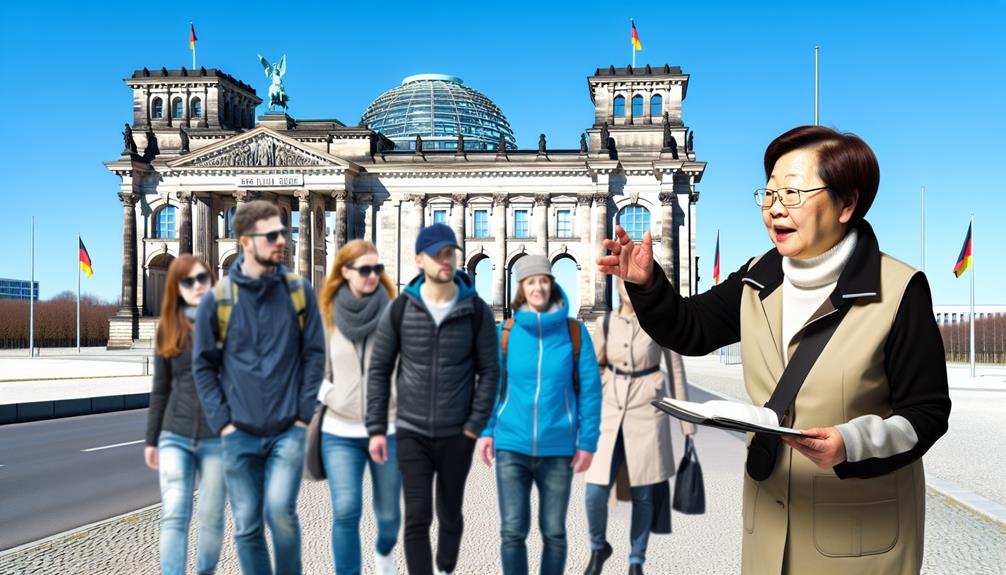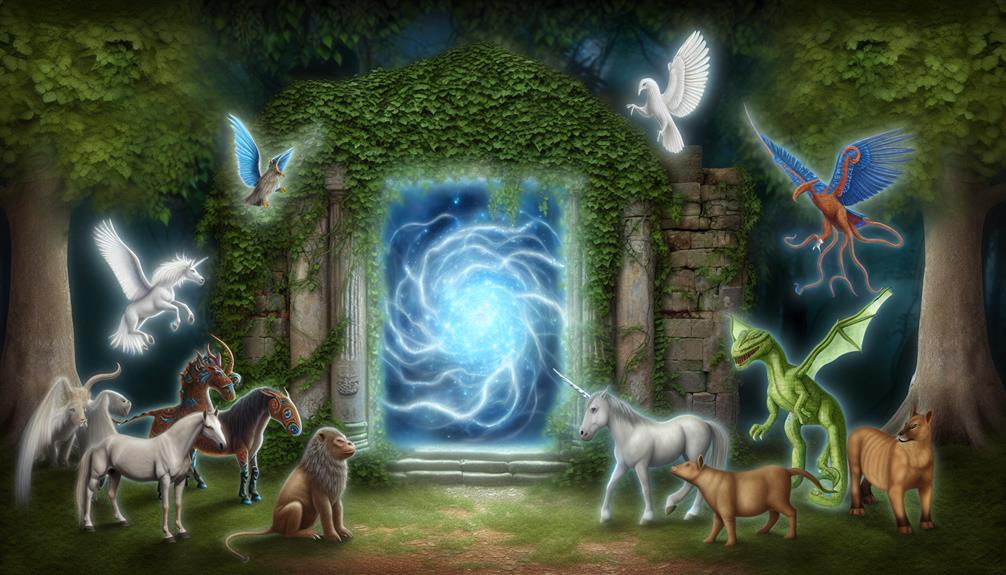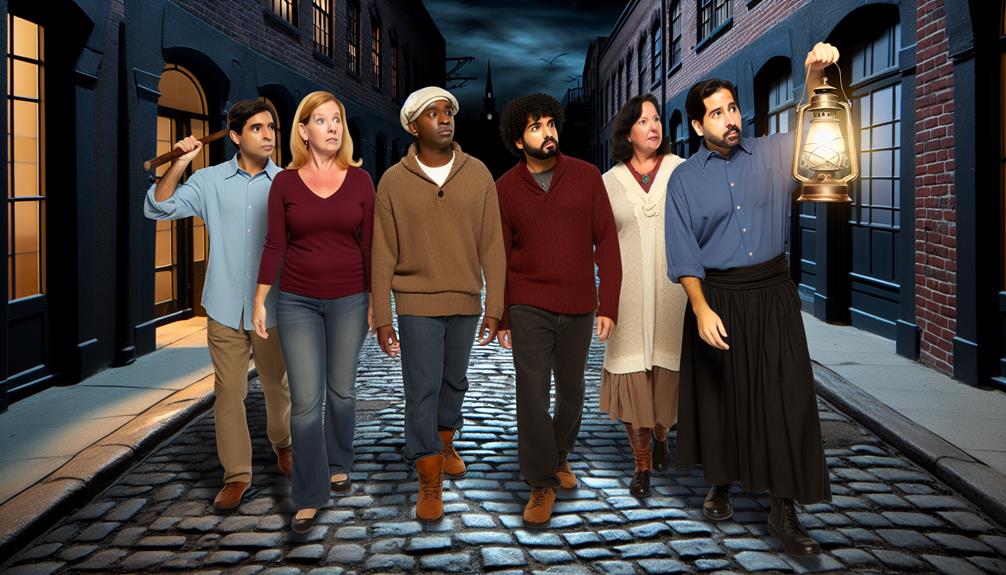Immerse yourself in the chilling remnants of a dark era by undertaking a Berlin Third Reich Tour in Germany. Uncover the haunting traces of Nazi influence scattered throughout Berlin's streets, each telling a tale of a tumultuous past. As you navigate through historical landmarks and somber memorials, the layers of history peel back to reveal a narrative that demands reflection and remembrance. This guided exploration offers a sobering yet essential perspective on a chapter of history that continues to shape Berlin's cultural fabric.
Key Takeaways
- Explore key Third Reich memorial sites in Berlin.
- Gain insights into Nazi architecture and propaganda.
- Understand the impact of the Third Reich on Berlin.
- Visit sites like Memorial to the Murdered Jews of Europe.
- Engage in guided tours for historical context.
Historical Background of Third Reich
The emergence of the Third Reich in Germany was a significant turning point in history, marked by the rise of fascism and the Nazi Party under the leadership of Adolf Hitler. The term 'Third Reich' referred to the Nazi regime in Germany, which lasted from January 30, 1933, when Hitler was appointed Chancellor, to May 8, 1945, when the Allied powers defeated Germany in World War II.
The rise of fascism in Germany during this period was characterized by extreme nationalism, authoritarianism, and the suppression of opposition. Adolf Hitler utilized propaganda techniques to manipulate public opinion and consolidate his power. Propaganda played a pivotal role in promoting the Nazi ideology, demonizing Jews and other minorities, and glorifying Hitler as a charismatic leader.
Hitler's propaganda machine, led by Joseph Goebbels, utilized various mediums such as radio, newspapers, posters, and films to spread their message effectively. They employed tactics like repetition, emotional appeals, and censorship to control the narrative and manipulate the masses. Through propaganda, the Nazi Party was able to create a cult of personality around Hitler, portraying him as a savior of Germany and a visionary leader.
Understanding the historical background of the Third Reich is essential when visiting Berlin, as it provides valuable insights into the dark chapter of German history and the consequences of unchecked power and propaganda.
Top Sites to Visit in Berlin
Berlin offers a plethora of significant historical and cultural sites for visitors to explore. When it comes to Berlin architecture, the Reichstag building is a must-visit. This iconic structure, with its glass dome offering panoramic views of the city, symbolizes Germany's democracy and resilience. The Brandenburg Gate is another architectural gem, serving as a symbol of peace and unity.
For those interested in WWII relics, the Topography of Terror is a haunting site that was once the headquarters of the Gestapo and SS. This outdoor and indoor museum provides a detailed look into the atrocities committed during the Nazi regime. The Memorial to the Murdered Jews of Europe, also known as the Holocaust Memorial, is a powerful and moving tribute to the millions of Jewish victims of the Holocaust.
Visitors can explore the remnants of the Berlin Wall, a stark reminder of the city's divided past, at the East Side Gallery. Covered in colorful murals, this open-air gallery stands as a symbol of freedom and unity. Charlottenburg Palace, with its baroque architecture and stunning gardens, offers a glimpse into Berlin's royal history.
Tour Itinerary and Schedule
Exploring Berlin's historical landmarks through a guided tour offers visitors a detailed itinerary and schedule to immerse themselves in the city's rich past and cultural significance. The tour itinerary typically includes visits to iconic sites such as the Reichstag building, the Memorial to the Murdered Jews of Europe, and the Topography of Terror exhibition. These locations serve as poignant reminders of the city's complex history during the Third Reich.
Participants can expect insider insights from knowledgeable guides who provide historical context and personal anecdotes, enriching the tour experience. These experts offer a deeper understanding of the events that unfolded in Berlin during the Nazi era, shedding light on the city's role in World War II and the Holocaust.
Moreover, guided tours often provide exclusive access to restricted areas and hidden gems not easily accessible to the general public. This privileged entry allows visitors to explore lesser-known sites with historical significance, offering a more thorough exploration of Berlin's past.
The tour schedule is carefully curated to make certain that participants have ample time to engage with each landmark, ask questions, and reflect on the significance of what they are witnessing. By following a structured itinerary, visitors can make the most of their time in Berlin and gain a profound appreciation for the city's historical heritage.
Guided Walk Through Nazi Era
Begin a guided exploration delving into the historical landscape of Nazi-era Berlin. Participants on this tour will have the opportunity to witness firsthand the remnants of Nazi architecture and propaganda art that still stand as eerie reminders of a dark chapter in history.
To provide a clearer picture, the table below outlines some key elements of Nazi architecture and propaganda art that are often encountered during the guided walk:
| Nazi Architecture | Propaganda Art |
|---|---|
| Reich Chancellery | Visual Art in |
| Tempelhofer Feld | Public Spaces |
| Olympic Stadium | Posters and Murals |
| Flak Towers | Exhibition Displays |
Nazi architecture, characterized by grandiosity and a focus on imposing structures, sought to convey power and authority. Buildings such as the Reich Chancellery, with its monumental design, aimed to intimidate and impress. On the other hand, propaganda art played an important role in shaping public opinion, using visual mediums to spread messages of nationalism and anti-Semitic ideologies. From posters adorning streets to murals in public spaces, these artworks were instrumental in promoting the regime's agenda.
As participants traverse through these sites, they will gain a deeper understanding of the visual language employed during the Nazi era and the lasting impact it has had on Berlin's architectural and artistic landscape.
Impact of Third Reich on Berlin
With profound repercussions that reverberate through the city's physical and cultural fabric, the impact of the Third Reich on Berlin remains palpable to this day. The architecture influence of the Nazi era is strikingly evident in Berlin. Monuments like the Reichstag building, which was severely damaged during World War II and later reconstructed, stand as a testament to the architectural ambitions of the regime. The imposing structures of the Tempelhof Airport and the Olympic Stadium, designed by Albert Speer, reflect the grandiose and oppressive architectural style favored by the Nazis.
Beyond the physical landscape, the cultural significance of the Third Reich era in Berlin is complex and profound. The suppression of artistic expression, the persecution of minorities, and the manipulation of public opinion left lasting scars on the city's cultural identity. The remnants of propaganda, such as the remnants of the Berlin Wall, serve as a reminder of the ideological divisions that once plagued the city. Additionally, the memory of the Holocaust and the atrocities committed during the Nazi regime continue to shape Berlin's cultural narrative, emphasizing the importance of remembrance and vigilance against totalitarian ideologies. The impact of the Third Reich on Berlin is a solemn reminder of the fragility of freedom and the enduring responsibility to safeguard democratic values.
Memorial and Remembrance Sites
Numerous memorial and remembrance sites in Berlin stand as poignant tributes to the victims and the dark history of the Third Reich era. These sites serve as powerful reminders of the atrocities committed during that time, ensuring that the memory of the victims is preserved and honored. Among the most notable memorial sites in Berlin are the Holocaust memorials and war monuments, each offering a unique insight into the horrors of the past.
To provide a clearer overview, the table below highlights some of the prominent memorial and remembrance sites in Berlin:
| Memorial/Remembrance Site | Description |
|---|---|
| Memorial to the Murdered Jews of Europe | Also known as the Holocaust Memorial, this site features a field of concrete slabs of varying heights, creating a somber and disorienting atmosphere. |
| Topography of Terror | Located on the site of the former Gestapo and SS headquarters, this outdoor and indoor exhibition documents the history of the Nazi regime and its crimes. |
| Soviet War Memorial at Treptower Park | Built to commemorate the Soviet soldiers who died in the Battle of Berlin, this memorial is a vast and impressive tribute to the fallen soldiers. |
| Neue Wache | Originally built as a guardhouse for the troops of the Prussian king, it now serves as the Central Memorial of the Federal Republic of Germany for the Victims of War and Dictatorship. |
These sites offer visitors a profound and sobering experience, allowing them to reflect on the past and pay their respects to those who suffered.
Tips for a Meaningful Experience
For a profound and enlightening visit to Berlin's Third Reich memorial sites, travelers can enhance their experience by following these insightful tips. To establish a meaningful emotional connection with the historical significance of these sites, it is important to approach them with a mindset of respect and understanding. Prior to your visit, take some time to educate yourself about the events of the Third Reich period, so you can better appreciate the gravity of what you will witness.
During your visit, allow yourself moments of personal reflection. Take the time to pause, absorb the surroundings, and contemplate the impact of the atrocities that occurred in these very places. Engage with the exhibits and information available, allowing yourself to feel the weight of history on your shoulders.
To deepen your understanding and connection, consider joining a guided tour led by knowledgeable experts. These guides can provide additional context, insights, and anecdotes that will enrich your experience and help you grasp the full scope of the historical events that unfolded in Berlin during the Third Reich.
Remember to approach these sites with sensitivity and humility. By fostering an emotional connection and engaging in personal reflection, you can make sure that your visit to Berlin's Third Reich memorial sites is both educational and deeply impactful.
Frequently Asked Questions
Are There Any Restrictions on Photography During the Tour?
Photography rules during tours can vary based on location, cultural norms, and privacy considerations. Understanding the specific guidelines regarding photography is vital to guarantee a smooth tour experience for all participants.
Restrictions on photography may be in place to protect historical artifacts, respect local customs, or preserve the privacy of individuals. It is advisable to familiarize oneself with the photography rules of a tour to avoid any disruptions and secure a positive experience for all involved.
Can Visitors Expect to See Any Original Nazi Artifacts?
Visitors on historical tours may anticipate encountering original Nazi artifacts of undeniable historical significance.
However, the ethical considerations surrounding preserving these items must be taken into account, balancing the imperative of education with the sensitivity of displaying such objects.
As guardians of the past, tour operators endeavor to provide a nuanced understanding of this dark period in history while upholding principles of respect and responsibility.
Is the Tour Suitable for Children and Families?
The tour offers child-friendly activities and family-friendly attractions, making it suitable for families with children. Visitors can expect an educational experience that provides historical significance without exposure to inappropriate material.
The tour carefully balances providing insight into the past while maintaining sensitivity towards younger audiences. Families can explore significant historical sites together, fostering a shared understanding of the past in a safe and respectful manner.
Are There Any Recommended Books or Documentaries to Learn More?
For those seeking a deeper understanding of the historical context surrounding the Third Reich, there are various recommended resources available.
Books such as 'The Rise and Fall of the Third Reich' by William L. Shirer and documentaries like 'The World at War' provide valuable insights into this period.
These multimedia options offer educational value and a thorough exploration of the events that shaped the era, making them essential for those interested in delving deeper into this significant period of history.
How Long in Advance Should Tickets Be Booked for the Tour?
When considering booking options for tours, it is advisable to plan in advance to secure availability, especially for popular or limited-capacity tours.
Tour duration and timing can vary, so understanding the specifics of the tour in question is essential for planning.
It is recommended to book tickets for tours well ahead of the desired date to guarantee availability and secure a spot on the desired tour.
Conclusion
To sum up, the Berlin Third Reich Tour in Germany offers a profound insight into the impact of the Nazi regime on Berlin's cultural landscape. By exploring historical landmarks and reflecting at memorial sites, visitors can gain a deeper understanding of the atrocities of the past.
This immersive experience serves as a poignant reminder of the dark era of the Third Reich and the importance of remembering and honoring the victims. Joining a guided walk through Nazi-era sites is an anachronistic journey through history that is both somber and enlightening.


